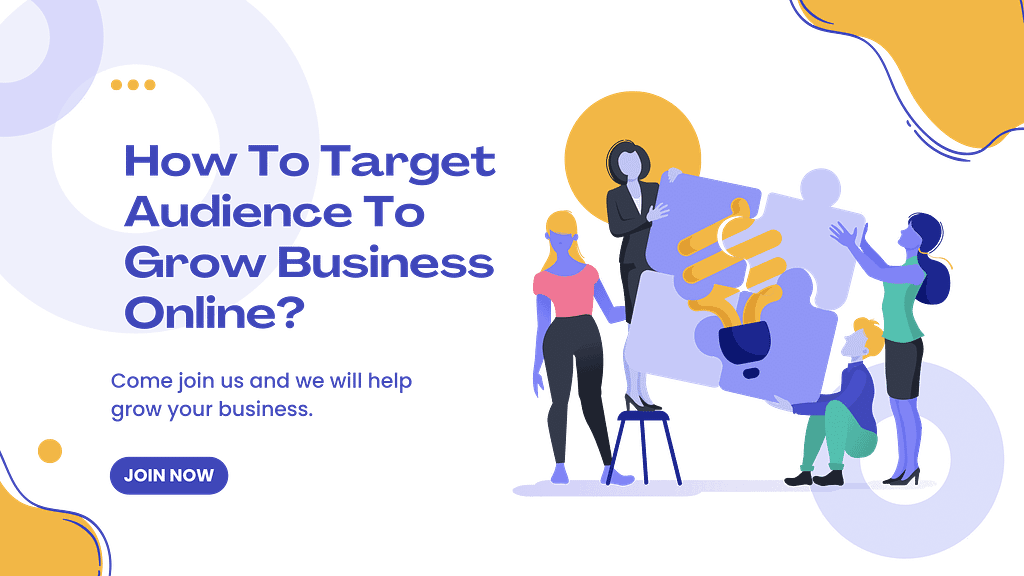Today, I am writing the post to define How to Target Audience To Grow Business Online, which benefits you in various aspects. In today’s time, everyone wants to grow their business, but the issue is due to a lack of technical knowledge they cannot expand their business. I’ll discuss multiple points and provide solutions or suggestions related to that.
Now day entrepreneurs make money through their businesses only two ways: first, if they have user information or data and second, those who have their audience on that related to platform. But the main thing is that those have an audience and then information will come automatically. So, don’t be late now to start today’s topic. I hope you will enjoy it, if yes and.
If you have any type of query regarding the article, you can connect with us via email at “info@query247.us” or “queryus247@gmail.com“.

Read Also: 50 Profitable Business Ideas for Startups in 2024 Trending
Targeting a Specific Audience
In the ever-evolving landscape of digital marketing, accuracy, and relevance have become essential for businesses seeking to inscribe a niche in their respective industries. In this blog post, we delve into the key concept of targeting a specific audience and explore its deep impact on promoting business growth.
By understanding the difficulties of reaching a defined audience, organizations can unlock the potential for more meaningful engagement and elevate conversion rates to exceptional heights. Join us as we unravel the significance of a targeted approach and discover how it can be a transformative force in the pursuit of sustainable success.
Understanding Target Audience To Grow Business Online
Define Your Ideal Customer
Identifying Characteristics: Finding your targeted audience is a crucial step for any business’s success. But there is a way to how do you define your ideal customer amidst a sea of potential faces. The answer lies in creating detailed customer personas – fictional representations of your ideal buyers, based on real data and insights.
Building a persona requires considering several key factors:
- Demographics: You can go with the Age, gender, location, income, education, and family structure all provide valuable context about your target customer’s background and lifestyle.
- Interests: Check What are their hobbies, passions, and values? Understanding their interests helps you tailor your messaging and connect with them on a deeper level.
- Behaviors: How do they spend their time online and offline? What are their purchasing habits and decision-making processes? Analyzing their behavior helps you predict how they’ll engage with your brand.
- Needs and problems: What are their biggest challenges and aspirations? Identifying their needs allows you to position your product or service as the solution they’ve been searching for.
- Media consumption: Where do they get their information and news? Knowing their preferred platforms helps you reach them effectively through targeted advertising and content marketing.
Benefits of Creating Customer Personas:
- Improved marketing effectiveness: You can create Custom messaging and campaigns that resonate better with specific audiences, leading to increased engagement and conversions.
- Enhanced product development: Personas guide product development by ensuring features and functionalities cater directly to user needs and desires, which is beneficial for you and your customers.
- Personalized customer experience: You can create a survey online or offline to understand their motivations and preferences. Businesses can personalize interactions and provide a more satisfying experience for each customer.
- Streamlined sales and customer service: With a clear understanding of their target audience, and you have a sales team, then can be well-qualified leads and customer service representatives can offer more relevant and efficient support.
Conduct Market Research

If you know that Market research plays a vital role in driving business success. By collecting insights into the industry, market trends, and customer behavior, businesses can make informed decisions, optimize their strategies, and ultimately achieve their goals. Here’s a breakdown of the process:
1. Define your goals and scope. What do you want to achieve with your research? What specific questions do you need answers to? How much time and resources can you dedicate?
2. Choose your research methods. You can utilize both primary (surveys, interviews) and secondary (industry reports, competitor analysis) research to collect complete information.
3. Collect data. You can ensure your methods are reliable, valid, and unbiased. Use a variety of tools to capture different perspectives.
4. Analyze data. Identify trends, patterns, and relationships to extract meaningful insights. Focus on the data that supports your research objectives. For trends, you can use Google Trends.
5. Report and present findings. Create a clear and concise report with data visualizations. Present your findings to stakeholders in a compelling manner.
6. Analyze competitors. You can research their strategies, websites, social media, and product offerings to learn from their successes and failures.
7. Set a budget and timeline. Be realistic and stick to your plan. Utilize technology and software to streamline your research process it is good for your business.
8. Seek help if needed. If you need some help then you can contact Experienced market research professionals who can offer valuable guidance and support.
9. Continuous learning and adaptation. Market research is an ongoing process. Be prepared to adjust your approach and strategies based on new information and insights. So be updated with the market and their demands.
Utilizing SEO for Audience Targeting

Keyword Research
In the domain of SEO, understanding user intent is not just a fancy phrase, it’s the cornerstone of successful keyword research. It’s the art of decoding what your target audience is truly seeking when they type a query into a search engine. You can use Google AdWords for Keyword research purposes.
Why is it so important?
- Relevance: You can match your content to the user’s intent, ensuring its relevance and value, ultimately leading to higher search rankings and organic traffic. If it is not relevant, then the user cannot engage with it and your bounce rate will become higher.
- Conversion: Targeting keywords aligned with user intent increases the probability of users taking the desired action, be it making a purchase, signing up for a service, or simply consuming your content. It is one of the best things everyone wants, so providing valuable details creates a higher chance of conversion.
- Improved user experience: When your content directly addresses the user’s needs, it provides a positive and satisfying experience, leading to increased engagement and brand loyalty. Because of that, users can rate your business, which makes your brand more trustable.
By identifying the user intent behind different keywords, you can:
- Choose the right keywords: Focus on keywords that align with your target audience’s needs and search behavior.
- Create relevant content: Craft content that directly addresses the user’s intent and provides valuable information or solutions.
- Optimize your website: Structure and optimize your website to match the user’s expected search experience.
Tools and techniques for understanding user intent:
- Keyword research tools: You can analyze search volume, keyword difficulty, and related keywords to gain insights into user behavior.
- SERP analysis: You can study the top-ranking pages for your target keywords to understand how other websites are addressing the user’s intent.
- User research: You can conduct surveys, interviews, and focus groups to gather direct feedback from your target audience.
On-Page SEO
On-page SEO, the art of optimizing individual web pages for search engines and users alike, forms the foundation of any successful SEO strategy. By strategically including relevant keywords, preparing compelling meta elements, and creating engaging content, you can enhance your website’s visibility and attract more organic traffic.
Here’s a breakdown of the key elements of on-page SEO:
1. Keyword Optimization:
- Target relevant keywords: You can research and identify keywords that your target audience is searching for and integrate them naturally throughout your content.
- Keyword density: Maintain a natural balance of keywords, avoiding over-optimization.
- Strategic placement: Include keywords in titles, meta descriptions, headings, and throughout the body of your content.
2. Meta Titles and Descriptions:
- Compelling meta titles: Craft clear, concise, and informative titles that accurately reflect the content of your page and attract users to click.
- Engaging meta descriptions: Summarize the key points of your content and include a call to action to encourage further exploration.
- Length optimization: Ensure your meta titles are under 60 characters and meta descriptions are under 160 characters.
3. Content Quality and Engagement:
- Create high-quality content: Focus on providing valuable information, addressing user needs, and offering unique insights and solutions.
- Structure your content: Use headings, subheadings, and bullet points to improve readability and scannability.
- Optimize for mobile: Ensure your website and content are responsive and optimized for mobile devices.
- Internal linking: You can connect relevant pages within your website to improve user navigation and search engine understanding.
- Freshness: Regularly update your content with new information and insights to keep users engaged and search engines crawling back for more.
Local SEO
Reaching the vast US market requires a focused approach. Local SEO strategies are crucial for businesses targeting specific American regions or communities. By optimizing websites and online presences for local search engines and users, businesses can attract more qualified leads and drive local traffic.
This involves strategies like:
- Claiming and managing Google My Business listings.
- Building citations in local directories and websites.
- Targeting relevant local keywords and search terms.
- Optimizing content for local search intent.
- Engaging with the local community through online reviews and social media.
Content Creation Strategies
Tailor Content to Audience Needs
Addressing Needs and Interests: You can emphasize the need for creating content that directly addresses the specific needs and interests of the target audience. Understanding their pain points and aspirations can guide content creation.
Diversify Content Formats
Meeting Preferences: You can Highlight the importance of diversifying content formats to cater to different audience preferences. This could include blog posts, videos, infographics, podcasts, etc.
Social Media Engagement
Choose the Right Platforms
Platform Selection: Each platform has its unique audience, and businesses should tailor their content accordingly.
Paid Advertising on Social Media
Targeted Ads: Paid social media advertising influences platforms like Facebook, Instagram, and Twitter to reach targeted audiences with paid content, increasing brand awareness, driving conversions, and achieving specific marketing goals.
Email Marketing
Build a Targeted Email List
You can build your own targeted email list by collecting email addresses from website visitors, social media followers, and offline interactions, ensuring your marketing messages reach the individuals most likely to engage with your brand.
Email Automation
Nurturing Leads: Businesses can send personalized and targeted content through automated email sequences based on user behavior.
Analyzing and Adjusting Strategies
Monitor Analytics
Tracking Audience Behavior: Check stress the importance of using analytics tools like Google Analytics to monitor audience behavior. Analyzing data helps businesses understand what is working and what needs adjustment.
A/B Testing
Refining Strategies: Businesses can test different elements of their campaigns and make data-driven decisions based on the results.
Call to Action (CTA)
Encourage Engagement: Encourage them to subscribe for more tips and updates, fostering ongoing engagement.
Submit your review | |



